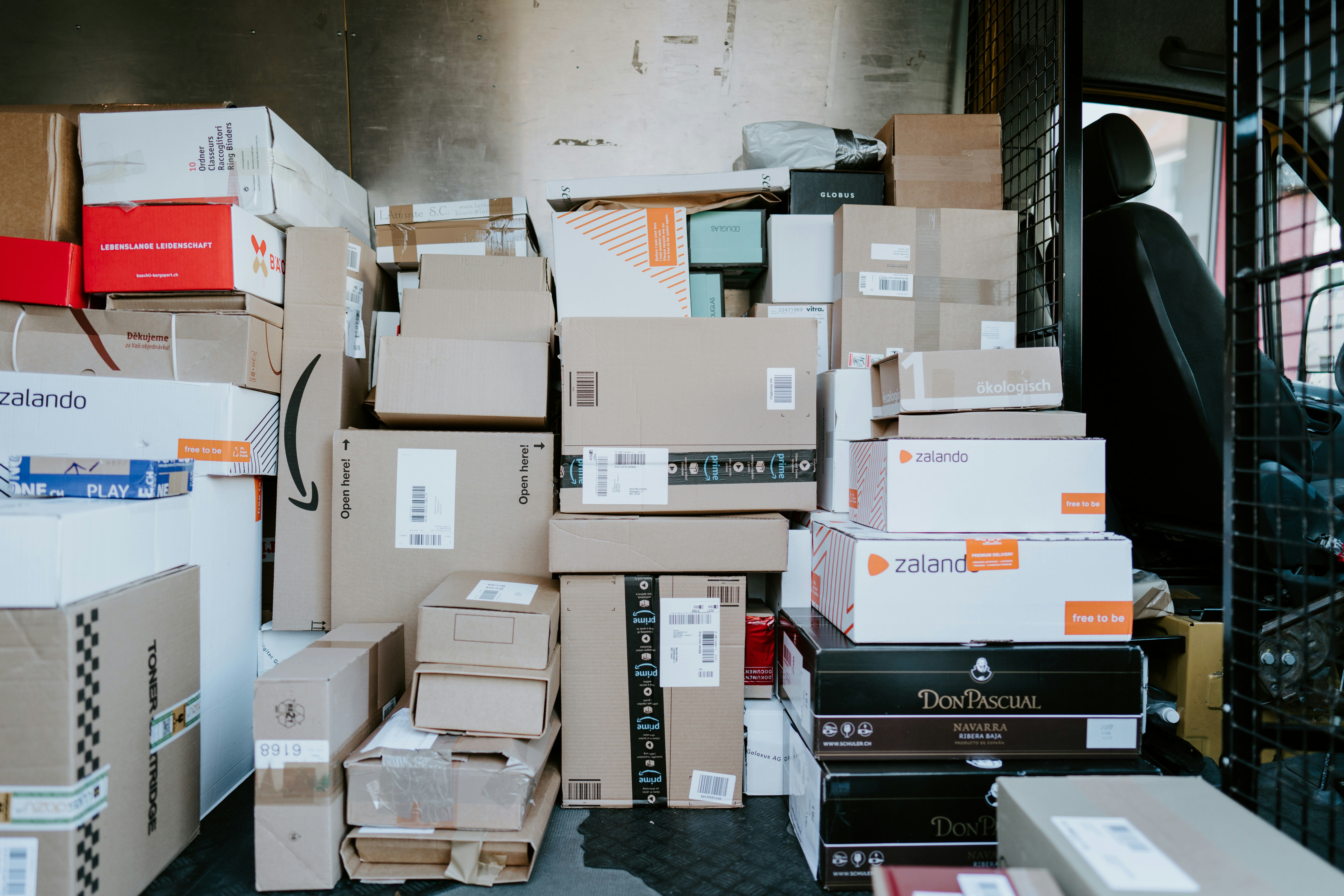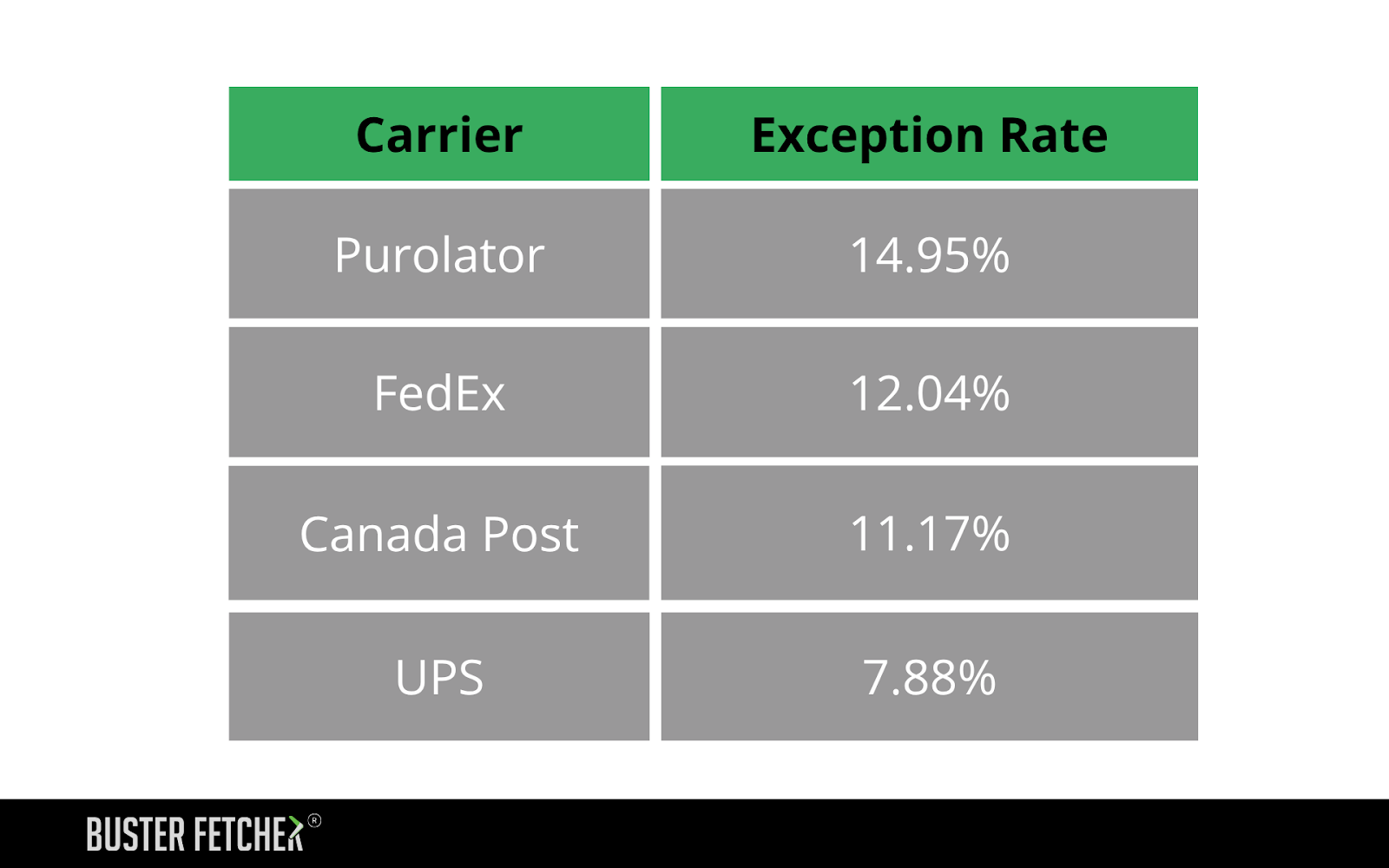Shipping Showdown: UPS vs. FedEx vs. Purolator

What the Data Really Says About Performance, Fees and Reliability
If you’ve ever had to explain to a customer why their package didn’t arrive on time—or had to comb through invoices to figure out what mysterious “fuel surcharge” just cost you an extra $47—you know this truth: not all shipping carriers are created equal.
In Canada, UPS, FedEx, and Purolator may be the big names, but each one has its quirks. Some are faster. Some tack on incomprehensible fees. Others are surprisingly solid when it comes to refunding you for their mistakes—if you know how to ask.
At Buster Fetcher, we’ve helped hundreds of businesses analyze shipping performance down to the decimal. Here’s what the data (and our clients’ real-world experiences) tell us about choosing the right carrier.
How do UPS, FedEx and Purolator Stack Up?
Let’s start with a bird’s-eye view. According to 2022 shipping data, here’s the lay of the land in Canada.
Market Share
According to Pitney Bowes, in 2023, this was the market share breakdown:
- UPS: 28%
- Canada Post: 19%
- Purolator: 15%
- FedEx: 13%
- Others: 17%
But market share doesn’t tell the whole story. You want to know: Which one actually delivers on their promises?
Delivery Speed and Service Reliability
Take one of our clients, Melissa, who runs a growing e-commerce store out of Montreal. She tested all three carriers during the holidays—a notoriously brutal time for shipping. What she found mirrored national trends:
- Purolator was lightning-fast within Canada, delivering 94% of her packages on time even during peak season.
- UPS gave her a sweet spot: not the fastest, but dependable for international deliveries, with fewer customs headaches.
- FedEx was her go-to for express services, but only when she had no room for error—and a bit more room in the budget.
Her experience mirrors the findings analyzed by EcomCrew when comparing UPS, FedEx, Purolator and Canada Post.
What Happens When Things Go Off Track
No carrier is perfect. But when delays or issues happen, the way each company handles them can make a real difference—especially to your bottom line.
Late Deliveries
Even a one-day delay in shipping can create a domino effect: lost sales, customer complaints, or refunds you weren’t planning on. That’s why knowing how often delays happen—and how they're handled—is critical.
In Q3 of 2023, Buster Fetcher analyzed thousands of shipments across Canadian businesses and found the following package exception rates (i.e., late deliveries):

That means nearly 1 in 7 Purolator shipments hit a snag, while UPS had the lowest rate of issues.
But here's the kicker: many businesses don't realize that you can often get refunded for late deliveries—if you catch them in time.
Hidden Fees and Surchargers
Most carriers publish their base rates, but the final invoice can look a little different once fuel, residential, or delivery area surcharges are factored in. Here’s what our data shows about average surcharges.
In a 2025 General Rate Increase Report, carriers have announced major hikes in surcharges based on a wide range of factors, including peak demand periods, parcel weight and size, delivery area, and more. It is important to read the fine print of each carrier’s rate guides and rate guide amendments.
- FedEx Canada Rate Guides and Amendments
- UPS Canada Rate Guides and Amendments
- Purolator Canada Rate Guides and Amendments
- Canada Post Rate Calculator for Small Businesses and Large Companies
These aren’t arbitrary charges—they reflect the cost of doing business in a complex delivery network. But for a business shipping hundreds of packages a week, even a 10% variance can snowball quickly.
To avoid surprises, it helps to understand which surcharges apply most often to your shipments and compare them across carriers.
How Businesses Can Optimize Shipping Costs
Shipping doesn’t have to be a black box of unpredictable fees and service issues. The most efficient businesses treat it like any other performance-driven operation: they track it, test it, and optimize it. Here's how.
1. Compare Before You Commit
Shipping rates change constantly, and what works today might not be the best option tomorrow. That’s why more businesses are using multi-carrier platforms to compare services in real time. These tools analyze not only price, but delivery speed, reliability, and surcharges based on the shipment’s size, weight, and destination. Check out Gartner’s latest analysis of multi-carrier parcel management solutions.
2. Negotiate Like a Pro
Carriers want your business, especially if you're shipping in volume. But they rarely offer discounted rates upfront. If you’re consistently shipping 100+ packages a month, you likely qualify for custom pricing—whether you’re a local business or an e-commerce giant.
The key is to come to the table with data: average monthly volume, package sizes, target destinations, and your current spending. That’s where carrier performance reports from platforms like Buster Fetcher can give you the edge in negotiations.
3. Audit What You’re Already Paying For
Many businesses assume their invoices are accurate. But between fuel surcharges, residential area fees, address correction charges, and delivery area surcharges, unexpected costs can quietly chip away at margins.
Regularly auditing your shipping invoices—ideally with automated tools—can uncover patterns: which customers consistently trigger extra fees, which service levels tend to arrive late, and whether certain carriers underperform during specific times of the year.
4. Automate Refund Claims
Here’s something most businesses don’t realize: If a package is late and the service level includes a delivery guarantee, you’re entitled to a refund. But most never claim it. Why? because tracking every shipment, filing paperwork, and following up takes time.
That’s where automation steps in. Tools like Buster Fetcher monitor your shipments across multiple carriers, and file refund claims the moment a package misses its delivery window—without you lifting a finger.
Why it matters: Even if only 5% of your shipments are eligible for a refund, that could translate into thousands of dollars a year back in your pocket—especially if you’re shipping at scale.
How Businesses Can Optimize Shipping Costs
At its core, Buster Fetcher is built to turn shipping chaos into clarity. For most businesses, keeping tabs on every shipment, every delay, and every fee is impossible. Things slip through the cracks—and with hundreds of deliveries each month, those cracks can add up to thousands of dollars lost in refunds, overcharges, and missed optimization opportunities.
That’s where Buster Fetcher comes in.
What It Actually Does
Think of Buster Fetcher as your behind-the-scenes shipping analyst and claims manager, all rolled into one.
Tracks every shipment: The platform connects with your shipping data to monitor performance across UPS, FedEx, and Purolator automatically.
Flags missed deliveries: If a carrier doesn’t deliver on time and a refund is possible, Buster Fetcher files the claim for you. No need to dig through tracking numbers or wait on customer service lines.
Audits for hidden costs: The system surfaces fees that often go unnoticed—like delivery area surcharges, fuel adjustments, or address corrections so you can make better decisions the next time you ship.
Provides actionable reports: Instead of spreadsheets that go unread and that are hard to maintain, you get clear insights about which carriers are performing, where you’re overspending, and how to improve your margins.
In conclusion, it is really up to you to make your shipping work for you. Shipping isn’t only about getting packages from A to B. It’s about protecting your margins, time, and customer experience. Choosing the right carrier helps, but what really moves the needle is having full visibility into carrier rates and what happens after you ship.
With Buster Fetcher, you get the data and automation to stop leaving money on the table—and start making every shipment truly count.
FAQs: Shipping Carrier Performance and Cost Optimization
Q: Which carrier is the best for fast delivery within Canada?
It really depends on where your packages are going. Purolator appears to have an edge when it comes to domestic speed—especially in major metro areas. However, if you’re shipping across borders or to more remote regions, UPS and FedEx tend to offer more consistency and broader reach. What works best often comes down to your specific routes and how time-sensitive your shipments are.
Q: How can I tell if I qualify for a refund on a late delivery?
Most major carriers offer a money-back guarantee if they miss their promised delivery window. But here’s the catch: they won’t notify you—it’s up to you to track it. That’s where tools like Buster Fetcher come in. They monitor your shipments and automatically flag the ones eligible for a refund, then file the claims on your behalf. It’s like having a shipping watchdog working quietly in the background.
Q: Are hidden fees really that common?
A: They’re not “hidden” on purpose, but they can definitely sneak up on you. Carriers often apply surcharges for things like residential delivery, extended zones, fuel costs, or even package dimensions that slightly exceed thresholds. On average, these extras can add 10% to 13% on top of your expected costs, depending on the carrier and the shipping profile. Knowing which fees affect your shipments most frequently is half the battle.
Q: What’s the most effective way to lower shipping costs?
A: There’s no one-size-fits-all answer, but businesses that succeed tend to do a few things really well: they compare rates across carriers before every shipment, negotiate based on actual volume, monitor performance, and automate refund claims for missed deliveries. Many also lean on tools like Buster Fetcher to help uncover patterns and opportunities they wouldn’t otherwise see. The more visibility you have, the more control you gain. The more control you have, the more savings you can pinpoint.


